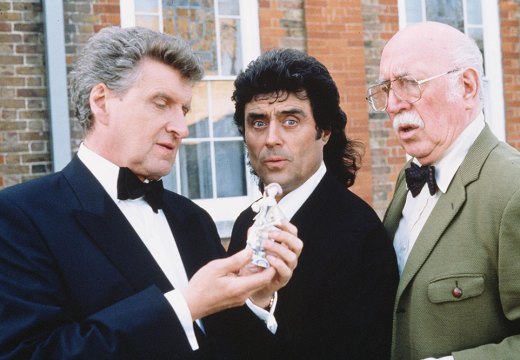From the June 2025 issue of Apollo. Preview and subscribe here.
There is an evocative photograph, taken during an early Rolling Stones tour in Ireland, of the late Charlie Watts reading in a train carriage. Outside the window, in the rain, three young women gaze keenly at the rock star at rest. Watts is oblivious to them. His attention is fixed on the latest issue of Apollo: September 1965, ‘Treasures from the Metropolitan Museum of Art’.
One of the pleasures of editing this magazine, as I did from 2013–21, is to notice the little ripples it has made, during a century of continuous publication, in the culture beyond its pages. That includes chancing on illustrious if unexpected readers such as Watts – or the food writer Elizabeth David, who used back issues of Apollo in the 1980s to research the illustrations for new editions of the cookery books that three decades earlier had made her name.
Apollo was perhaps most visible during the quarter-century regime (1962–87) of the art historian Denys Sutton, an editor so sure of his billing that he installed the motto ‘Edited by Denys Sutton’ on the magazine’s cover. Sutton was a prolific writer and curator, contributing long articles to most of the issues he oversaw while also making time during his tenure to knock out books on Whistler and Sickert and organise exhibitions on Bonnard and others.
In accounts of the period, alas, Sutton is remembered chiefly for his intemperateness. ‘Of course Sutton is a beast,’ wrote the diarist James Lees-Milne in 1978 after the editor had sacked Lees-Milne’s nephew from a job at Apollo. ‘Sutton could be a tyrant,’ Vanessa Nicolson recalls in her memoir, Have You Been Good? (2015). Her own departure from a role at the magazine, she recounts, was precipitated by the editor’s rage on receipt of a letter from the Queen of Denmark, pointing out a mix-up with the image captions in an article about Danish castles.
When Sutton took on Apollo, John D. Wright has written, ‘the magazine […] was thin and dullish, but Sutton immediately expanded it, made it more attractive and widened its scope’. If not a household name, Apollo in the 1960s certainly became familiar to a wider culturally literate audience than it had previously mustered. In Barrie Sturt-Penrose’s The Art Scene (1969), a mischievous popular survey of the ‘international art world’, the frontispiece shows the author kitted out as a tramp, asleep on a bench alongside assorted back issues of Arts Review, The Connoisseur and Apollo.
In 1967, two years after Charlie Watts had rejected the charms of Venus for those of Apollo, the magazine appeared prominently on screen in Joseph Losey’s Accident, an unsettling psychological thriller about dons and their lawless libidos. In one scene the fellows of an Oxford college sit in the senior common room as one reads aloud an article about the sex lives of undergraduates in Milwaukee. The provost, played by Alexander Knox, lowers his copy of Apollo on learning that 0.1 per cent of students have engaged in sexual activity during a lecture on Aristotle: ‘I am surprised to hear that Aristotle is on the syllabus in the state of Wisconsin,’ he says.
Elsewhere in film and fiction, Apollo has sometimes appeared as a means to emphasise the aesthetic or social aspirations of characters. Orvil Pym, the protagonist of Denton Welch’s delicate coming-of-age novel, In Youth is Pleasure (1945), squeezes the magazine for inspiration in imagining a fantastical studiolo encrusted with precious stones and works of art: ‘Orvil had learnt many interesting facts from the pages of the magazine Apollo, which he saw regularly at school’, Welch writes, ‘so he was able, from his memory of these, to furnish the most intricate details for his fantastically rich dream closet.’ William Beckwith, the idle, hedonistic narrator of Alan Hollinghurst’s first novel, The Swimming-Pool Library (1988), cannot bring himself to buy War Picture Library comics for a lover, Arthur, because – as a friend observes – ‘it would sort ill with Apollo, Tatler and GQ’ at the local newsagents.
There are further examples: Apollo as a period detail in Man in an Orange Shirt (2017), a BBC adaptation of a novel by Patrick Gale charting the lives of two gay couples, following the Second World War and in the present day respectively; or the magazine’s frequent cameos in the comedy drama Lovejoy (1986–94), usually on the desk or in the studio of one art-world swindler or another. And then there are the near misses. There’s no reference to Apollo in Patricia Highsmith’s Ripley novels, for instance, even when their anti-hero is enthusiastically feeding forged paintings to the London art market. But surely Tom Ripley, that most connoisseurial of conmen, is an Apollo reader – right?
From the June 2025 issue of Apollo. Preview and subscribe here.













![Masterpiece [Re]discovery 2022. Photo: Ben Fisher Photography, courtesy of Masterpiece London](http://www.apollo-magazine.com/wp-content/uploads/2022/07/MPL2022_4263.jpg)
Apollo at 100